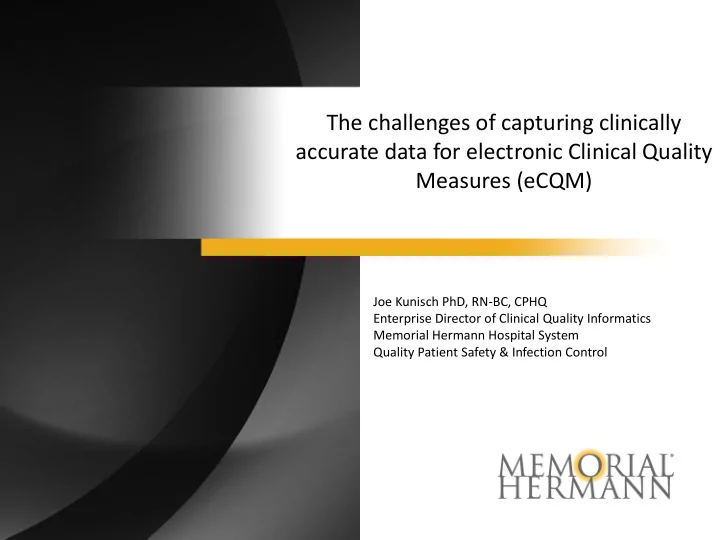

The challenges of capturing clinically accurate data for electronic Clinical Quality Measures (eCQM) Joe Kunisch PhD, RN-BC, CPHQ Enterprise Director of Clinical Quality Informatics Memorial Hermann Hospital System Quality Patient Safety & Infection Control
Current Challenges of Capturing eCQMs • Data must be discrete- able to be identified by a distinct computer code • Data is constrained to value sets- a value set determines what text-based terms are included • Data capture can be limited to specific fields- i.e. a check box in a single EHR form • Data may be required to be captured at certain points in time or workflow- i.e. in the first 24 hours of admission • Data may reside in disparate information systems- i.e. partly in an EHR and partly in a diagnostic system
Volume of eCQM Cases Across 9 Hospitals Physicians & Nurses must complete documentation 100% of the time on 100% of the patients in the same method electronic Clinical Quality 2015 Total eCQM Abstraction (100%) Measure (eCQM) Sets Emergency Department Patients 503,340 Patients Venous Thromboembolism 104,892 Patients Patients Perinatal Quality Measures 52,667 Patients
eCQM Example VTE-6
eCQM Example VTE-6 • Incidence of Potentially-Preventable Venous Thromboembolism • This measure assesses the number of patients diagnosed with confirmed VTE during hospitalization (not present at admission) who did not receive VTE prophylaxis between hospital admission and the day before the VTE diagnostic testing order date. • Failure to prevent VTE can result in delayed hospital discharge or readmission, increased risk for long-term morbidity from post-thrombotic syndrome, and recurrent thrombosis in the future.
eCQM Example VTE-6 Case Scenario: Patient is brought into the hospital emergency room after suffering a fall at home. Patient also has slurred speech, is confused and notable swelling to the left leg. Head and Pelvis CT Scan confirms left subarachnoid hemorrhage and right fractured hip. D-Dimer lab result is elevated. Patient is admitted to the Neuro ICU, orders include ultrasound study to the left lower extremity to rule out DVT but the patient deteriorates and the test it delayed until day 3 of inpatient stay.
Discrete, coded and defined appropriately Initial Population: Patients age 18 and older discharged from hospital inpatient acute care with a non-principal diagnosis of venous thromboembolism (VTE). • The principal diagnosis is defined in the Uniform Hospital Discharge Data Set (UHDDS) as 'that condition established after study to be chiefly responsible for occasioning the admission of the patient to the hospital for care.‘ • Physician documents in text note confirmed SAH, right hip fracture and possible LLE embolism because of the swelling and elevated D- Dimer. • Which one is the principal diagnosis? • What was present on admission (POA)?
Data may reside in disparate information systems • Denominator = "Initial Patient Population" • ◦ AND: "Occurrence A of Diagnostic Study, Order: VTE Diagnostic Test" starts during "Occurrence A of Encounter, Performed: Encounter Inpatient" • AND: First: "Occurrence A of Diagnostic Study, Performed: VTE Diagnostic Test (result: VTE Confirmed)" starts during Occurrence A of Encounter Inpatient
Data may reside in disparate information systems • Ultrasound test was ordered at admit but was not performed until day 3 of inpatient status. • Are all the data elements recorded in the EHR or a common database? • If the test results are captured in a separate information system, how is recorded in the EHR? • Is it discrete? Is it text based? Does documenting it in a discrete data field within the EHR require a new workflow? • Who is responsible for documenting a positive finding in a newly created EHR form created to capture the discrete data?
Data constrained by value sets and limited to time span Denominator Exclusions = "Diagnosis, Active: Venous Thromboembolism" AND • Emergency Department Visit" <= 1 hour(s) ends before Inpatient Encounter, OR: <= 1 day(s) starts after Inpatient Encounter starts • Specific time frame for when a physician enters a diagnosis determines if the patient is excluded or not • "Diagnosis, Active: VTE" using "VTE SNOMEDCT Value Set (2.16.840.1.113883.3.117.1.7.1.279)"
Data constrained by value sets
Recommendations to increase clinical data accuracy • Involve clinicians in the conceptual phase of any measure development • Understand how the data is normally captured in the workflow • Understand how the data is used and it’s importance in the clinical domain • Understand the impact that data mapping may have on the success of capturing clinically accurate data • Success= The ability to extract existing data without a change in the EHR interface or the clinical workflow.
This image cannot currently be displayed.
Recommend
More recommend